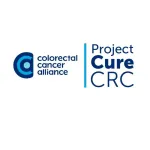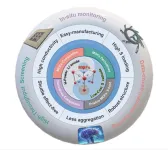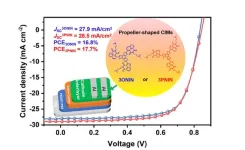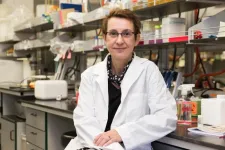(Press-News.org) Patients who have drug-resistant tuberculosis (TB) have a similar microbiological response to bedaquiline-based second-line medications as patients with drug-sensitive TB taking first-line regimens, according to researchers at Weill Cornell Medicine in New York and GHESKIO Centers in Haiti. Second-line medications are those that are given when one or more of the drugs given first for the disease are not effective. The research could have implications for shortening the duration of treatment for drug-resistant TB, which currently requires medications for up to 2 years, while those with drug-sensitive TB complete treatment in about 6 months.
The study, published Dec. 7 in The Journal of Infectious Diseases, “is thought to be the first to address the knowledge gap surrounding the microbiological response of patients receiving these two therapies,” said the paper’s lead author Dr. Kayvan Zainabadi, assistant professor of molecular microbiology at Weill Cornell Medicine.
“We found that the new drugs we use to treat the drug-resistant form of the disease are as effective as our first-line medicines,” said study co-author Dr. Daniel W. Fitzgerald, director of the Center for Global Health at Weill Cornell Medicine. “Historically, they were much worse.”
Evolving Treatments for a Devastating Disease
Mycobacterium tuberculosis, the bacterium that causes TB, infects the lungs, causing cough, fever and often death. Worldwide, 10.6 million people developed the condition in 2022, resulting in about 1.3 million deaths, according to the World Health Organization (WHO), making it the top infectious disease killer worldwide. Approximately four percent of new TB infections are drug-resistant, which disproportionately contribute to 12 percent of deaths from the disease.
In 2012, the United States Food and Drug Administration approved bedaquiline, the first new TB drug in four decades, leading the WHO to update treatment guidelines for drug-resistant TB in 2018. The new guidelines allowed for bedaquiline, an oral drug, to replace the more toxic injectable antibiotics such as streptomycin. These new regimens are also much easier to implement in the resource-limited settings where TB is common. Together these factors improve the chances of patients completing treatment, which is important because not doing so results in more drug resistance, Dr. Zainabadi said.
Due to differing drug availabilities across the world, there is no single standard bedaquiline-based second-line regimen for drug-resistant TB. Rather the WHO recommends using a combination therapy consisting of different classes of antibiotics based on availability and local drug resistance patterns. How these new oral, bedaquiline-based second-line treatments compare to first-line therapies in their ability to kill the bacteria is not well understood and prompted the research team to conduct their research.
The Study Data
For this study, the researchers assessed 31 subjects with drug-sensitive TB who took first-line treatment (rifampin, isoniazid, ethambutol, and pyrazinamide) and 23 subjects with drug-resistant TB who took second-line treatment (bedaquiline, pyrazinamide, levofloxacin, linezolid, and clofazimine). Patients were enrolled through Weill Cornell Medicine’s partner in Haiti, the Haitian Study Group on Opportunistic Infections and Kaposi's Sarcoma, or GHESKIO.
The researchers measured the number of bacteria in the patient sputum using an automated clinical test as well as sophisticated laboratory methods capable of detecting cryptic bacteria that typically go undetected by routine methods. They then looked at the rate of the decrease in bacteria over time with therapy.
“The laboratory work to measure the quantity of bacteria in sputum is incredibly laborious and requires bio-safety level 3 facilities, so it's not something you can do on a thousand people,” said Dr. Fitzgerald, who is also the B.H. Kean Professor in Tropical Medicine and professor of medicine in microbiology and immunology at Weill Cornell Medicine.
“The rate of decline measured at two weeks was comparable in the two groups by all measures,” said study statistician Dr. Myung Hee Lee, associate professor of clinical epidemiology in medicine and associate professor of statistics. Just two months after treatment, 77.8 percent of patients from both groups tested negative for the bacterium.
“Patients who have drug-resistant TB tend to have advanced disease, and most have previously been treated with first-line drugs,” Dr. Zainabadi said. “Seeing them respond at the same rate as drug-sensitive patients to treatment is encouraging.”
The comparable response observed in the study may mean treatment can be shortened in drug-resistant patients. However, he noted that resistance to one of the other drugs in the regimen, pyrazinamide, was associated with slower killing of the bacterium during the first two weeks of therapy. These patients may need to be monitored and treated for an extended time.
These study results also support two clinical studies from other institutions, not yet published in peer-reviewed journals, that evaluated patient outcomes, Dr. Zainabadi said.
Future Research
The Weill Cornell Medicine researchers want to build on prior studies in Scientific Reports and mBio investigating better tools for monitoring the disease, Dr. Zainabadi said. “What we’re really missing is a clinical diagnostic that can accurately monitor how patients are responding to therapy, including how well regimens are killing TB, and when cure is achieved.”
The researchers are also conducting studies using the newer drugs, including bedaquiline, as an alternative to the first-line regimen in people with drug-sensitive-TB, said Dr. Fitzgerald. Some patients can’t tolerate the first-line treatment or are allergic to some of the drugs, he said.
“Overall research is moving in the direction of finding new drug regimens for TB and shorter and shorter treatments,” Dr. Fitzgerald said. “We now have options for patients.”
END
Drug-resistant tuberculosis responds rapidly to bedaquiline-based second-line therapy
2024-02-27
ELSE PRESS RELEASES FROM THIS DATE:
Colorectal Cancer Alliance announces Request for Proposals (RFP) as it launches the largest-ever CRC research investment totaling tens of millions
2024-02-27
In an effort to expedite its life-saving work, the Colorectal Cancer Alliance (Alliance) Project Cure CRC initiative is excited to open its Request for Proposals (RFP). Tens of millions of dollars will be available to researchers from around the world whose work aims to expedite colorectal cancer (CRC) research to a curable science. Beginning March 1, the program is accepting applications for one to three-year projects from qualifying professionals at research-based institutions and private companies. Priority will be given to proposals that focus on high-risk/high-reward projects to accelerate new CRC therapies and technologies from bench to bedside.
The ...
Reaching federal youth sport participation goal could save US billions of dollars
2024-02-27
First-of-its-kind study suggests increasing the percentage of youth in the United States who participate in sports to meet a Healthy People 2030 goal could improve children’s physical and mental health and save $80 billion.
Achieving the Healthy People 2030 youth sports participation goal could save the United States $80 billion in direct medical costs and productivity losses and deliver over 1.8 million more quality years of life to Americans, according to a study that will be published on Feb. 27 in the American Journal of Preventive Medicine.
Every decade since 1980, Healthy People has provided science-based, 10-year national objectives and ...
Improving lithium-sulfur batteries with metal organic framework-based materials
2024-02-27
Current lithium-ion battery technology does not have the energy density necessary to meet the demands for renewable energy. In theory, lithium-sulfur batteries could be a viable alternative with a higher specific capacity and energy density. However, sulfur has disadvantages that currently limit its practical adoption.
A comprehensive review published in Nano Research on February 8 outlines how metal organic frameworks-based cathode materials could improve the performance of lithium-sulfur batteries, making them a practical alternative to lithium-ion batteries.
“The ...
An alternate arrangement: how a propeller-shaped isomer can improve organic solar cells
2024-02-27
Imagine technology as a race car speeding down a track – it can only go as fast as its engine allows. But just when it seemed like organic solar cells hit a roadblock, along comes 3PNIN, a game-changing molecule shaped like a propeller, ready to turbocharge their progress and break through barriers.
Organic solar cells (OSCs) represent the pinnacle of renewable energy, yet certain components have fallen significantly behind the trajectory of ongoing development. Particularly, cathode interfacial materials (CIMs) have failed to sustain ...
Binghamton University biologist named Fellow of American Academy of Microbiology
2024-02-27
BINGHAMTON, N.Y. -- Binghamton University, State University of New York researcher Karin Sauer is among 65 scientists elected as Fellows of the American Academy of Microbiology this year.
Fellows are elected by their peers based on their scientific achievements and original contributions to the field of microbiology.
Sauer’s lab aims to find ways to control communities of bacteria called biofilms and to curb their extraordinary resistance to antimicrobial agents. The team’s findings could have an impact on a wide range of healthcare practices, from ear infections to wound care.
“I’m honored and ...
Community culture shapes ceramics
2024-02-27
Archeologists have long used the shapes and styles of pottery as a proxy for ancient cultures. But how does the cultural alignment of ceramic forms arise? To explore this question, Tetsushi Nonaka and colleagues asked 21 potters in three different communities—one in France in Bourgogne and two in India in Bulandshahar district, Uttar Pradesh—to throw pots with the same unfamiliar shapes. One of the Indian pottery workshops was Hindu, the other was Muslim. In each community, several different potters tried the shapes. Through careful measurement, the authors were able to determine ...
Nano-sized particles emitted from gas stoves
2024-02-27
A study quantifies the emission of extremely tiny particles by gas stoves and finds that the particles could harm human health. Airborne nanoparticles between 1–3 nm, referred to as nanocluster aerosol or NCA, are known to be bioactive and toxic, but measuring such minute particles has been a challenge. Brandon E. Boor and colleagues measured indoor NCA during propane gas cooking in the Purdue zero Energy Design Guidance for Engineers (zEDGE) test house using a novel instrument. Combining measurement data with the general dynamic equation for aerosols, the authors were able to characterize the production and behavior ...
Reproducing the Moon's surface environment on Earth
2024-02-27
Continuous research is being conducted globally on using the Moon as an advanced base for deep space exploration, and Korea is no exception in these efforts. The Korea Institute of Civil Engineering and Building Technology (KICT, President Kim, Byung-suk) successfully implemented an electrostatic environment that simulates the Moon's surface conditions, not in space but on Earth. The researchers also assessed its performance and effectiveness.
Among the most serious threats in executing lunar missions is the Moon's surface environment, which is electrostatically charged. Due to its extremely thin atmosphere, the Moon is directly exposed to solar ultraviolet rays, X-rays, ...
Social media and adolescent mental health
2024-02-27
In an editorial, Sandro Galea and Gillian Buckley summarize the findings of a National Academies of Sciences, Engineering, and Medicine consensus study report on social media and adolescent mental health. Social media has to some extent been treated as a monolith, but the report finds that different types of engagements with different digital platforms may have very different effects on mental health. In some situations, social media may benefit adolescent mental health, as when LGBTQ+ adolescents in isolating circumstances are able to form supportive ...
How decades of expertise with the fourth state of matter could bring satellites closer to Earth
2024-02-27
Thousands of satellites take pictures, gather information and relay internet traffic from high above the Earth. Now, the challenge is making satellites that operate closer to home, in what is called a very low earth orbit (VLEO), where there is ample space for additional satellites, and the pictures taken would be clearer.
Working at an altitude with air would mean more force would be needed to propel the satellite forward, but many scientists believe there is also an advantage: the air could be used as the propellant. They say charged particles of air-breathing plasma – the fourth state of matter – could be used to propel the thrusters, potentially ...







